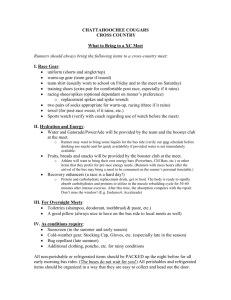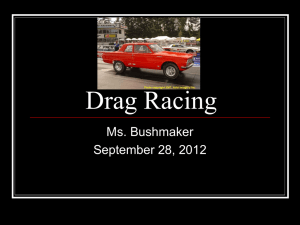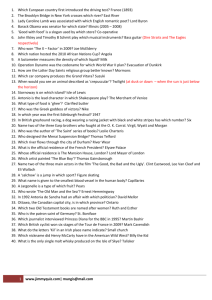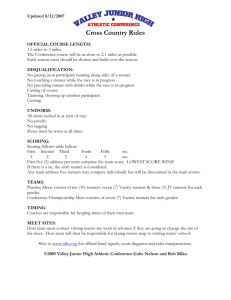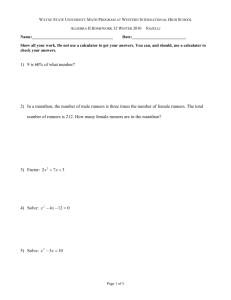Content for Website
advertisement
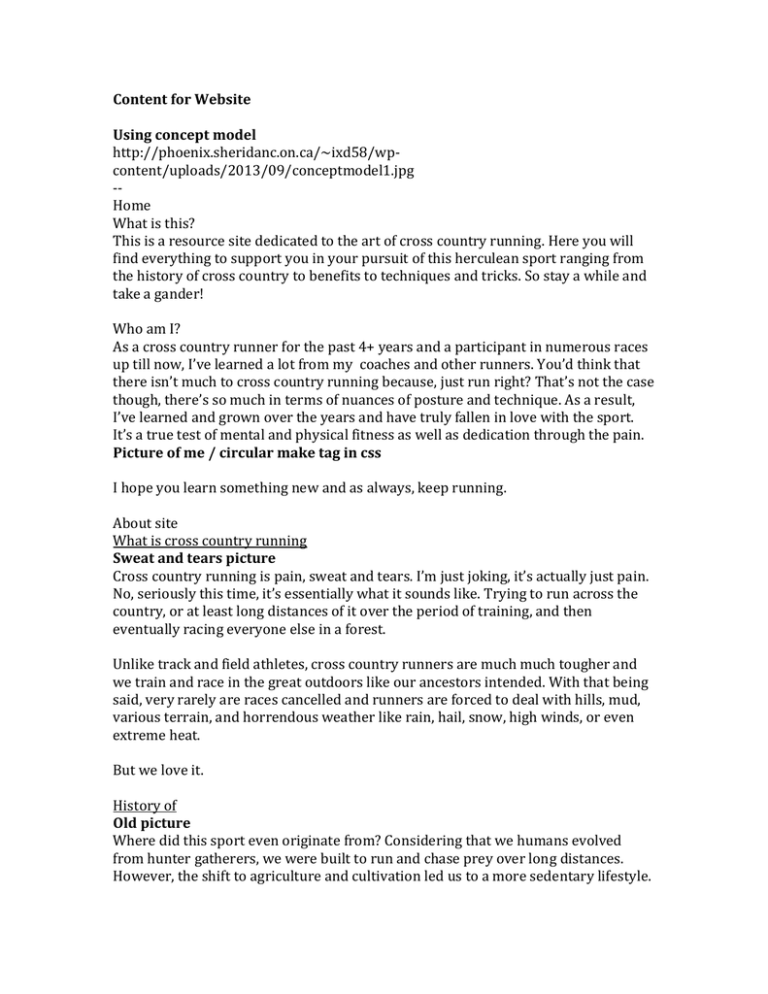
Content for Website Using concept model http://phoenix.sheridanc.on.ca/~ixd58/wpcontent/uploads/2013/09/conceptmodel1.jpg -Home What is this? This is a resource site dedicated to the art of cross country running. Here you will find everything to support you in your pursuit of this herculean sport ranging from the history of cross country to benefits to techniques and tricks. So stay a while and take a gander! Who am I? As a cross country runner for the past 4+ years and a participant in numerous races up till now, I’ve learned a lot from my coaches and other runners. You’d think that there isn’t much to cross country running because, just run right? That’s not the case though, there’s so much in terms of nuances of posture and technique. As a result, I’ve learned and grown over the years and have truly fallen in love with the sport. It’s a true test of mental and physical fitness as well as dedication through the pain. Picture of me / circular make tag in css I hope you learn something new and as always, keep running. About site What is cross country running Sweat and tears picture Cross country running is pain, sweat and tears. I’m just joking, it’s actually just pain. No, seriously this time, it’s essentially what it sounds like. Trying to run across the country, or at least long distances of it over the period of training, and then eventually racing everyone else in a forest. Unlike track and field athletes, cross country runners are much much tougher and we train and race in the great outdoors like our ancestors intended. With that being said, very rarely are races cancelled and runners are forced to deal with hills, mud, various terrain, and horrendous weather like rain, hail, snow, high winds, or even extreme heat. But we love it. History of Old picture Where did this sport even originate from? Considering that we humans evolved from hunter gatherers, we were built to run and chase prey over long distances. However, the shift to agriculture and cultivation led us to a more sedentary lifestyle. Despite this, the origins of cross country stem from a game that was a mimicry of the hunter lifestyle. This sport originated in England as a “hare chase” in schools for where children of different ages would take on different roles. There were the hares, the hounds, and the hunters. The hares would run ahead with a 10 minute lead and drop a paper trail such that the ‘hounds’ may follow. Hares would often zigzag and circle areas to try and confuse the hounds chasing. Once the hares were within site, the hunters, another group of older students would go in for the kill and sprint down to tag the hares. From this game, cross country was spawned, a sport involving runs over distances from 5 km and upwards generally. Src: http://www.runnersworld.com/rt-columns/origins-cross-country Benefits Heart rate picture Cross country isn’t just fun and games though, there are many psychological and health benefits as well. The body is a machine and is meant to work as thus, sitting around and staying idle allows your body to wither away and in a sense, rust. The best way to combat that is with daily cardio exercise like cross country running. Cardio exercises are activities that increases the heart rate and gets the blood pumping. Some of the benefits of daily cardio activity are: -helps to burn off excess calories which makes it helpful for weight loss -improved heart health as the heart is muscle like any other, this in turn will increase one’s capacity to exercise as the heart will be able to pump a greater capacity of blood per beat -increases one’s metabolism to help maintain or lose weight -activity releases feel good hormones like oxytocin which help fight depression and stress -prevent cardiovascular diseases like atherosclerosis and thrombosis -helps to manage high blood pressure by clearing the arteries of buildup On top of that, it will just make you feel better! Src: http://www.bodybuilding.com/fun/sclark85.htm -Self care Rest Pic sleeping Getting enough rest is one of the most essential elements of any sport, especially before race day. Especially in cross country, sufficient sleep is crucial in allowing the body to recover from a hard day’s workout as it gives the body time to repair muscles and allow you to get stronger. As a side benefit, more exercise will help you sleep better, but you need to remember to actually set aside time to sleep! The optimal amount of sleep for a teenager aged 12-18 is around 8-10 hours, sometimes more sometimes less depending on the amount of sleep debt incurred. Ideally before a race, you should get at least 9-10 hours of sleep in order that your body is as fresh and rested as possible. If for any reason (life), you don’t get enough sleep for race day, try and take it easier on that race as you will be less attentive and more likely to injure yourself. Injuries Injury pic Injuries are unavoidable in a sport such as this where the majority of the time is spent battling mother nature. Random tree stumps or roots and hills are bound to trip even the best runner up sometimes and you just have to know how to deal with them Race day If you become injured before a race, do not push yourself to run. You risk seriously aggravating the injury and turning something as simple as a sprained ankle into major tendon injuries. Losing a race is not as important as the future wellbeing of your body. If you become injured during the race, please slow down and assess the extent of the injury. As stated before, don’t push yourself and risk your future well-being. Races usually will have medics on hand so please seek help if you’ve injured yourself. In many cases, the endorphins will dull the pain of injuries so it is doubly important that you take the time to assess yourself. Joints and Muscles These are the most common types of injuries that occur and include cramping as well. The best way to combat injuries is: stretching and warm up. Lots and lots of stretching, before and after and race will alleviate some of the soreness that postrace brings. If you feel pain in any of your joints, such as knees or hips when you run, it’s a good idea to take a few days off of training and see if that will make it go away. If not, get a support (you can easily buy supports for knees or ankles). If the pain is still bad, seek medical help. Cramping occurs when muscles undergo spasms due to either overexertion or random occurrence. If you experience a cramp, the best method is to stretch it out. It will hurt but it will all be worth it! If it’s during race time and you experience a cramp in the abdominal region, raise your arms above your head and fold your hands toward the opposite elbow. This helps to improve circulation to the abdominal region and reduce cramping. Injuries are inevitable but you can do your best to make sure they don’t become permanent, so take care of your body and it will take care of you. Nutrition Next to rest, nutrition is the other most important aspect of a runner’s life. Include pictures Water It is so incredibly important to stay hydrated on a daily basis, not just when you’re racing or competing. The recommended amount of water intake for a normal adult is about 2L a day. That’s a lot of water bottles so get drinking (but please do use the reusable ones and not the throwaway plastic ones). However, while it is important to stay hydrated on a race day, try and make sure you drink most of your water at least 2-3 hours before your race and not to drink tons just before racing. You don’t want to have to run to a bathroom break in the middle… Nutrients / for injuries Eating a proper diet as according to canada’s food guide should be general behavior. However, additions should be made to a runner who is training and racing. I know that whenever cross country season comes around, I start eating about twice the amount I normally do. That is normal! Do not deprive your body of food as your metabolism is much quicker and you need the extra energy to repair muscles. Make sure that you’re eating lots of protein, items like fish, red meats, and vegetables to give your body the building blocks it needs to handle the exercise. Race Day The food you intake around and during race day is important to the success of that day. Here’s a general timeline to follow to prepare for a race The day prior to racing you should try and eat a good dinner of carbohydrates, this will provide you with long lasting energy for the day Avoid high protein items like red meat as it takes your body much longer to digest that and convert it into energy Eat a banana the day of the race as it will help to prevent cramps Stay hydrated but do not over drink the day of the race Here’s to happy racing! -Techniques Race day Race day is the culmination of all your hard work and training, so it’s best to go in prepared. Make sure that you arrive early to the meet as you want the extra time to calm your nerves as well as take a tour of the actual trail you’ll be racing. It’s suggested that you actually walk through the race trail so you’ll know when and where to turn/loop/reverse. Of course, there are some handy tricks that will help you compete at top form. Psychological tricks There are many tricks you pick up for racing when you’ve been racing and training for as long as I have. Here I’m going to share some that will make your racing life hopefully more successful. Breathing There are many different breathing methods but the one I’ve used the most is pure breath in mouth, breath out mouth. Some people suggest breathing in through the nose and breathing out through the mouth to allow for quicker air exchange but it doesn’t work for me. Others perform pure nose breathing. Experiment and find what works best for you. On cold days, it is suggested that you breathe in through the nose and out through the mouth as your nose will warm up the air a bit such that you don’t dry out your mouth or experience as much of that stinging sensation of cold air in your throat. Pacing The thing about pacing is that it mostly comes down to the quality and quantity of training that the runner has done. However, what many of my coaches and what I believe to be valid is that you should know where the mid-way point is and try and run your second lap faster than your first. This way, you’ll be lapping many of the runners who over exerted themselves in the first half of the race. No way is this a easy task to accomplish though as I’ve tried out myself, you’re tired and in pain, but remember that you won’t remember it after you’ve passed the finish line so trek on! Corners Many courses, especially golf courses will offer turns that runners must fit through. In these instances, if there are other runners around, increase your pace as you go around a corner because it is a psychological demotivator to other runners as you will be out of sight briefly. Terrain/weather Hills Hills…ah the bane of cross country lover. In 90% of the courses you run, there will be some absolutely painful hills, both big and small that you will have to traverse over. The best way to deal with uphill is to shorten your steps and pump your arms. Rely on mostly upper body strength to get yourself up that hill and then lengthen your strides going downhill. This allows gravity to carry you down the hill and for you to go faster. Try your best to speed up near the top of the hill as most runners will be slowing down Mud/Rain Mud and or rain is unavoidable as races are conducted outside so one just has to learn to deal with. Make sure you’ve got in spikes with the appropriate length of spikes installed to combat all that mud and provide grip. In terms of rain, just keep your head down a little bit more and wear a headband if you can. If you wear glasses. Switch to contacts. Wind Wind is something that can be helpful or hurtful. Do your best to run with the wind and not against it. When it is truly unavoidable, try and tuck in behind another runner so that they will block the wind for you. Despite what one might think, running headlong into wind wastes about 10% of the exerted energy. Training Training is an essential part of doing well in any sport. You train to perform your best on race day just like any artist works fervently in their sketchbooks to be able to deliver beautiful finished pieces. It requires, of course, commitment. Do not overthink it, just do it. Set a time schedule for yourself to train at the same time every day and just stick to it, you’ll thank me on race day. These are some elements that should be incorporated into everyone’s training. The important thing is to vary it up, don’t do the same thing every day. Warming up I cannot stress how important it is for you as an athlete to get used to warming up. It gives your muscles a chance to loosen up and is one of the fundamental elements in preventing injuries as more elastic muscles equals less injuries. Try to go for a couple of strides, stretch out the legs, arms, back to abdominal area, as well as rotation of ankles, knees, and arm sockets. Include pictures Endurance Within your training regiment, you should dedicating at least one day to endurance training. Essentially forcing yourself to go out for long runs and push the limits of your distances by 1km or so each time you go out for an endurance run in a week. This way, you’ll rack up the kilometers and will be better able to deal with race distances. Speed Many runners overlook this area in their training but it is crucial if you want to actually improve your times and place well. Speed training is not about distance, so running very fast in short intervals. Hilly areas are exceptional for this type of training as you can go 1 minute fast, 1 minute jogging for around 20 minutes. This prepares the body to deal with speed changes within a race and aids in endurance as well. Strength Finally, strength training. It’s not a huge part of cross country runners as we develop most of our sleek muscles during our endurance and speed training, but it should be incorporated to deal with some of the muscle groups that often get neglected. Runners should try their best to incorporate strength workouts for the abdominals and pectorals. -Equipment Shoes Shoes are obviously one of the most important aspects of cross country racing and there are two kinds that every serious cross country runner should own. Racing spikes Training shoes Racing spikes are thin lightweight shoes that have screwable metal spikes on the bottom of the shoe that help provide traction when running on trails. They work best on trail, grass, and mud like surfaces but will provide almost a suction effect on pavement. They are good for racing because they don’t weigh down a runner and provide the necessary grip. However, one should not run in racing spikes because they wear down very quickly and also don’t provide ankle support. Make sure to have a nice pair of sneakers that have lots of ankle support. Ask for cross country or trail running shoes when you go out to buy them and remember to read reviews! Clothing Clothing is the next necessary equipment to obtain. Whilst running naked is fun, it’ll get chilly when winter hits. In terms of clothing, lightweight, moisture wicking but heat reflecting clothing is the best type to invest in. You’ll want a combination of short sleeves, long sleeves, and thinner jackets, as well as shorts and long runner’s tights to take on any kind of weather. Also a pair of gloves is helpful for the winter and comfortable athletic socks are a must have. The key to dressing like a cross country runner is to layer. Cold? Layer. Hot? Take off a layer. Less bulk, more effective. Final note is for females. A good sports bra goes a long way to keeping you comfortable during runs and will make sure you perform without any pesky luggage in the way. -Contact/submissions See anything we missed? Want to suggest a topic to cover? Have a comment that you’re dying to share? Just leave some necessary info below and we’ll get back to you in a jiffy!
